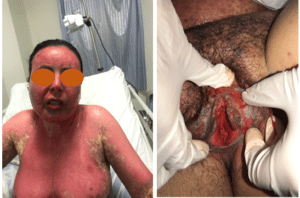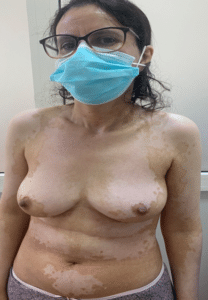I Couissi1*, Z Douhi1, K Mejjati1, M Soughi1, SEL Loudi1, H BayBay1, M Soughi1, FZ Mernissi1
1Université Sidi Mohamed Ben Abdellah de Fès, Fez city, Morocco
*Correspondence author: Imane Couissi, Université Sidi Mohamed Ben Abdellah de Fès, Fez city, Morocco; Email: [email protected]
Published Date: 29-06-2023
Copyright© 2023 by Couissi I, et al. All rights reserved. This is an open access article distributed under the terms of the Creative Commons Attribution License, which permits unrestricted use, distribution, and reproduction in any medium, provided the original author and source are credited.
Abstract
Background: Toxic Epidermal Necrolysis (TEN) is a serious adverse drug reaction causing a potentially fatal mucocutaneous bullous rash and epithelial detachment.
It is increasingly recognized that survivors may develop late sequelae, some of which may be associated with significant morbidity.
Few studies have mentioned autoimmune diseases as late complications of TEN.
Case report: We report the case of a patient hospitalized for TEN who developed long-term Hashimoto’s thyroiditis and Sjögren’s syndrome.
Conclusion: Toxic epidermal necrolysis has a major impact on long-term quality of life. A prolonged multidisciplinary follow-up including a social follow-up is necessary.
Keywords: Toxic Epidermal Necrolysis; Gastrointestinal Tract; Mucosa; Autoimmune Diseases
Introduction
Toxic Epidermal Necrolysis (TEN) is a serious adverse drug reaction inflicting a potentially fatal mucocutaneous bullous rash and epithelial detachment [1]. It is known nowadays that patients may additionally develop long-term complications, the most common is mucocutaneous and ocular complications though other internal organ complications, such as the respiratory tract and gastrointestinal tract can also be seen [2-4]. Few studies have stated autoimmune diseases as a long-term complication of toxic epidermal necrolysis.
Case Report
A 38-year-old patient with no preceding records was hospitalized in our health facility for Lyell syndrome confirmed histologically, following the consumption of coffee combined with traditional plants one week prior. The patient did not file any precise symptoms, all evolving in a context of feverish sensation and alteration of the general state.
A general exam discovered a hemodynamically stable conscious patient with a fever of 38.3 degrees Celsius. Dermatological examination found a couple of erythematous macules and papules, purpuric in places, diffuse over the whole body with wet linen detachment on the back and the presence of more than one confluent vesicles in flaccid bubbles with clear and purulent contents on the trunk and the anterior face of the forearms with a positive Nikolsky sign.
The affected skin surface was estimated to be 63%. The mucosal exam found the presence of erosive cheilitis and a couple of clean-surface erosions in the genital and anal areas (Fig. 1).
The patient was hospitalized in an isolated, heated room and put on daily Chlorhexidine baths, silver sulfadiazine on the erosions and oral preparation, eye drops, parenteral nutrition, and a mini bolus of methylprednisolone at the dose of 500 mg per day for three days. Given the non-improvement of the patient ten days after, she was put on intravenous immunoglobulin 2 g/kg/d three days in a row with a stabilization of the disease. After a month of being hospitalized, the patient began to show signs of improvement: the possibility of enteral nutrition, the healing of erosions on the skin and mucosa, the negativity of Nikolsky sign, with dyschromic areas, moderate conjunctival hyperemia (Fig. 2).
Regarding the nails, there has been diffuse onychomadesis, with a decrease in scalp density and a positive traction sign, which disappeared after 6 months. However, two years after, the patient reported photosensitivity, and arthralgia of the large joints, with a sensation of sand inside the eyes and a dry mouth (Fig. 3).
A sugar test was performed with a positive result, completed by biopsy of the accessory salivary glands which showed a stage four chronic sialadenitis. The ophthalmic examination showed xerophthalmia with a positive Schirmer test.
A biological check-up showed positive antinuclear antibodies with a mottled appearance with negative native DNA antibodies, positive anti-SSA, and anti-SSB antibodies in favor of Gougerot Sjogren’s syndrome, and positive anti-thyroglobulin and anti-thyroperoxidase antibodies with an elevated TSH and normal T3 and T4, in favor of Hashimoto’s thyroiditis. The patient was put, therefore on levothyroxine and hydroxychloroquine which resulted in satisfactory disease control.

Figure 1: Erosive areas on the trunk, the upper limbs and the face, erosive cheilitis and erosions in the genital area.

Figure 2: Dyschromic areas on the trunk, the upper limbs, and the face.

Figure 3: Hypochromic areas on the trunk.
Discussion
Toxic Epidermal Necrolysis (TEN) is a severe cutaneous drug reaction characterized by extensive exfoliation of the epidermis and mucous membrane, where the affected body surface area is more than 30%, which may result in sepsis and death. Long-term sequelae are defined as the cause of the identified disease after the resolution of the toxicoderma or the cause of the disease at some stage in the toxicoderma that persists at least one month after its resolution.
A limited number of studies have reported long-term complications of TEN over long follow-up periods. Few studies have mentioned autoimmune diseases as late complications of TEN. Among those autoimmune diseases, systemic lupus erythematosus and Hashimoto’s thyroiditis, and Sjögren’s syndrome were the most commonly observed.
In a retrospective study of long-time period complications in patients admitted for Steven Johnson Syndrome (SJS), SJS/TEN overlap, or TEN between 1998 and 2012, autoimmune diseases were present in 6 patients: Gougerot’s syndrome in five patients and concomitant systemic lupus erythematosus and Hashimoto thyroiditis in one patient [5].
CW Yang, et al., reported two patients with primary Gougerot’s syndrome and one patient with systemic lupus erythematosus and Hashimoto thyroiditis diagnosed at the same time one year after TEN [6].
In our case, the patient presented Gougerot’s syndrome associated with Hashimoto’s thyroiditis two years after TEN. The relationship between toxic epidermal necrolysis and autoimmune disease has not yet been established. A study has stated functional impairment of regulatory T-cells (Treg) throughout the acute phase in TEN patients, while restoration of Treg function was observed during recovery. Patients in the resolution phase had a lower frequency of interferon-γ-producing Treg [7].
However, to this day, there may be no direct proof that toxic epidermal necrolysis is incriminated in the pathogenesis of autoimmune diseases.
Conclusion
A prolonged multidisciplinary follow-up is necessary for toxic epidermal necrolysis. The interest in a rigorous systemic examination at each consultation: screening for complications and evaluating the function of the salivary glands and asking for a serological assessment in any symptomatic patient after the episode of TEN.
Conflict of Interest
The authors have no conflict of interest to declare.
References
- Roujeau JC, Stern RS. Severe cutaneous adverse reactions to drugs. N Engl J Med. 1994;10:1272-85.
- Revuz J, Penso D, Roujeau JC. Toxic epidermal necrolysis. Clinical findings and prognosis in 87 patients. Arch Dermatol. 1987;123:1160-5.
- Wetter DA, Camilleri MJ. Clinical, etiologic and histopathologic features of Stevens-Johnson syndrome during an 8-year period at Mayo clinic. Mayo Clin Proc. 2010;85:131-8.
- Magina S, Lisboa C, Leal V. Dermatological and ophthalmo- logical sequels in toxic epidermal necrolysis. Dermatol. 2003;207:33-6.
- Yang CW, Cho YT, Chen KL, Chen YC, Song HL, Chu CY. Long-term sequelae of Stevens-Johnson syndrome/toxic epidermal necrolysis. Acta Dermato-Venereologica. 2016;96(4):525-9.
- Patel R, Shahane A. The epidemiology of Sjögren’s syndrome. Clin Epidemiol. 2014;6:247-55.
- Yoshioka N, Suto A, Abe R, Saito N, Murata J, Hayashi- Ujiie I, et al. Disturbed balance in three subpopulations of CD4(+)Foxp3(+) regulatory T cells in Stevens-Johnson syndrome and toxic epidermal necrolysis patients. Clin Immunol. 2013;148:89-91.
Article Type
Case Report
Publication History
Received Date: 24-05-2023
Accepted Date: 21-06-2023
Published Date: 29-06-2023
Copyright© 2023 by Couissi I, et al. All rights reserved. This is an open access article distributed under the terms of the Creative Commons Attribution License, which permits unrestricted use, distribution, and reproduction in any medium, provided the original author and source are credited.
Citation: Couissi I, et al. Autoimmune Diseases a Late Complication of Toxic Epidermal Necrolysis: A Case Report. J Dermatol Res. 2023;4(2):1-4.

Figure 1: Erosive areas on the trunk, the upper limbs and the face, erosive cheilitis and erosions in the genital area.

Figure 2: Dyschromic areas on the trunk, the upper limbs, and the face.

Figure 3: Hypochromic areas on the trunk.


